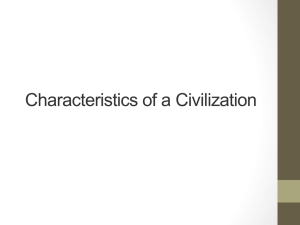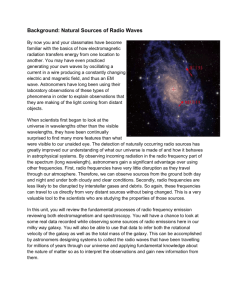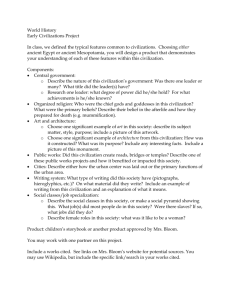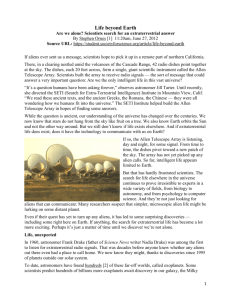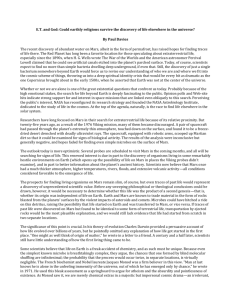Would ET Phone or Write?
advertisement
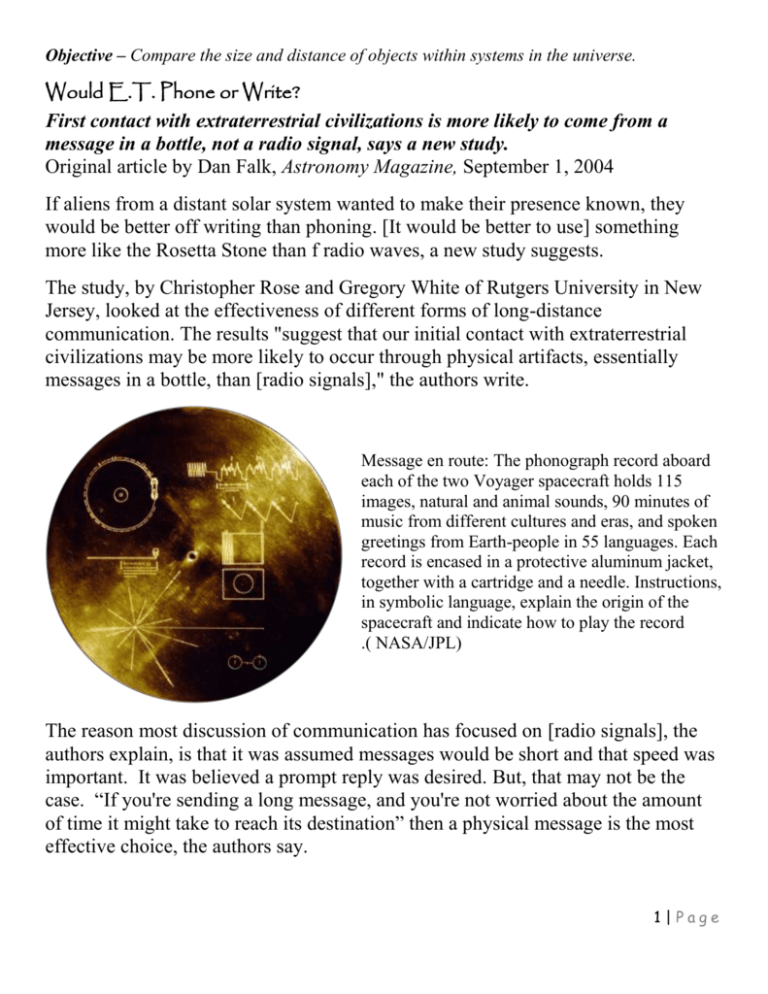
Objective – Compare the size and distance of objects within systems in the universe. Would E.T. Phone or Write? First contact with extraterrestrial civilizations is more likely to come from a message in a bottle, not a radio signal, says a new study. Original article by Dan Falk, Astronomy Magazine, September 1, 2004 If aliens from a distant solar system wanted to make their presence known, they would be better off writing than phoning. [It would be better to use] something more like the Rosetta Stone than f radio waves, a new study suggests. The study, by Christopher Rose and Gregory White of Rutgers University in New Jersey, looked at the effectiveness of different forms of long-distance communication. The results "suggest that our initial contact with extraterrestrial civilizations may be more likely to occur through physical artifacts, essentially messages in a bottle, than [radio signals]," the authors write. Message en route: The phonograph record aboard each of the two Voyager spacecraft holds 115 images, natural and animal sounds, 90 minutes of music from different cultures and eras, and spoken greetings from Earth-people in 55 languages. Each record is encased in a protective aluminum jacket, together with a cartridge and a needle. Instructions, in symbolic language, explain the origin of the spacecraft and indicate how to play the record .( NASA/JPL) The reason most discussion of communication has focused on [radio signals], the authors explain, is that it was assumed messages would be short and that speed was important. It was believed a prompt reply was desired. But, that may not be the case. “If you're sending a long message, and you're not worried about the amount of time it might take to reach its destination” then a physical message is the most effective choice, the authors say. 1|Page Objective – Compare the size and distance of objects within systems in the universe. "If you don't worry about [the time involved], then it's much better to write the thing down," Rose told Astronomy. "Radio seems really good, but it disperses rapidly [the farther the distance travelled]. Mass doesn't behave that way." It would have a much greater "information density," with billions of bits of information packed into a tiny volume. Such a feat has become far more possible in recent years thanks to advances in nanotechnology. The authors consider a message containing as much information as three standard DVDs. They compare the amount of energy needed to send it physically, using a Voyager-size space probe, to that required to send and receive the same information via a radio beam. They would use a pair of radio telescopes the size of the Arecibo dish in Puerto Rico, the world's largest. If the target is more than 200 light-years from Earth, say Rose and White, the DVDs is more efficient. Interstellar communication via radio waves is best for short messages where speed is of the essence. Otherwise, say Rose and White, send inscribed matter. NAIC / NSF It is possible artifacts from an alien civilization may have found their way to our Solar System already. The authors suggest a number of places we might look for messages – the moons, around planets, etc. Looking for such artifacts could be a new approach to the Search for Extraterrestrial Intelligence (SETI). "Our results suggest that carefully searching our own planetary back yard may be as likely to reveal evidence of extraterrestrial civilizations as studying distant stars through telescopes," the authors write. Woodruff Sullivan, an astronomer at the University of Washington in Seattle, cautiously agrees with the Rose/Wright paper. He wrote an article published in the 2|Page Objective – Compare the size and distance of objects within systems in the universe. same edition of the journal. He points out some weaknesses in their argument. For example, the amount of energy required to send a radio message may not be important to the sender. Sullivan also cautions there is no guarantee a matter message "would ever in fact be recognized as such." That is also a problem with a message sent using radio signals. Seth Shostak, senior astronomer at the SETI Institute, agrees that efficiency may not be that important. Rose and Wright assume that messages would move no faster than 1/1,000th the speed of light (about 170,000 mph). This is far faster than today's rockets travel. To reach a nearby star system would take tens of thousands of years. "They say they're not worried about speed," Shostak says. "But in any real situation you would be worried about speed." After such immense spans of time, he asks, how could you even be sure that the civilization you were targeting would still exist? "Hundreds of thousands of years might be a long time compared to the lifetime of a technological society," he says… At the very least, the paper seems to be making scientists re-think some assumptions about interstellar communication. Rose and Wright have "an intriguing idea," says physicist David Spergel of Princeton University. "Since we are completely ignorant about the goals of an alien civilization, it is worth trying all plausible approaches." 3|Page Objective – Compare the size and distance of objects within systems in the universe. Would E.T. Phone or Write? Worksheet 1. A new study suggests it would be better to use something like the Rosetta Stone than this to send messages through space. a. Radio waves b. Gamma rays c. UV radiation d. Infrared rays 2. It would be better to send a “message in a bottle” than to use radio waves. a. True b. False 3. A record with information about Earth was put on which space probes? a. Mariner b. Ranger c. Pioneer d. Voyager 4. It’s better to write things down… a. if it’s a short message. b. because it’s cheaper. c. if time doesn’t matter. d. it’s quicker and easier. 5. If we want to send information to a target over 200 light years away, using something like a _________ would be more efficient. a. CD b. DVD c. flash drive d. floppy disc 6. One place we might look for artifacts from other worlds is the… a. Kuiper Belt. b. Surface of Mars. c. Oort Cloud. d. the moons of the planets. 4|Page Objective – Compare the size and distance of objects within systems in the universe. 7. One problem we might face with any matter messages that were sent is… a. we may not find them. b. we may not recognize them as messages. c. they are too far away. 8. Another problem with matter messages is… a. they would travel to slow. b. a civilization may not have survived. c. it would take too long to arrive. d. all of the above. 9. Even though we are ignorant about the goals of an alien civilization, it is not worth trying all possible approaches. a. True b. False 5|Page Objective – Compare the size and distance of objects within systems in the universe. Would E.T. Phone or Write? Worksheet - Key 1. A new study suggests it would be better to use something like the Rosetta Stone than this to send messages through space. a. Radio waves 2. It would be better to send a “message in a bottle” than to use radio waves. a. True (2 choices) 3. A record with information about Earth was put on which space probes? b. Voyager 4. It’s better to write things down… c. if time doesn’t matter. 5. If we want to send information to a target over 200 light years away, using something like a _________ would be more efficient. b. DVD 6. One place we might look for artifacts from other worlds is the… d. the moons of the planets. 7. One problem we might face with any matter messages that were sent is… b. we may not recognize them as messages. (3 choices) 6|Page Objective – Compare the size and distance of objects within systems in the universe. 8. Another problem with matter messages is… d. all of the above. 9. Even though we are ignorant about the goals of an alien civilization, it is not worth trying all possible approaches. b. False (2 choices) 7|Page


